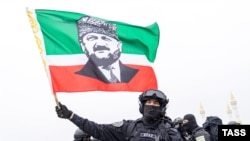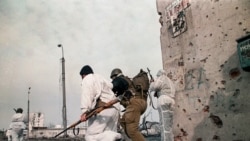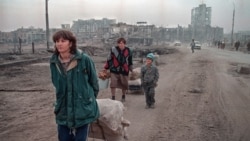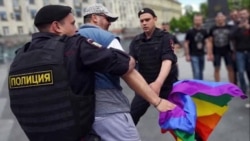Since the Russian President Vladimir Putin attacked Ukraine, his protégé to the south, Chechnya’s Ramzan Kadyrov, has turned his Telegram channel of more than a million followers into an anti-Kyiv propaganda platform.
In one post on March 14, Kadyrov shared a 4,000-word essay to explain his views on the West, Russia and Ukraine, with the weighty title, "The collapse of the unipolar world.” In it, he echoes many of the bogus claims Putin and other top Russian officials have used to justify killing thousands of Ukrainians.
Kadyrov, however, went further. Not content to be a mere Kremlin mouthpiece, his essay spins out a specious history of Chechnya that blames the West and not Russia for two brutal wars that subjugated his republic.
Kadyrov wrote:
“The Chechen people have experienced on themselves the entire arsenal of evil and insidious actions of the West. Without realizing it, we got involved in an illusory adventure that cost the lives of hundreds of thousands of people. Our people were used by the West in their attempt to break up Russia."
The statement is false.
In fact, the Chechen people fought for independence from a Russian invasion in 1994-1996, and again in 1999-2000, with an insurgency that continued until 2009. The first war, under former President Boris Yeltsin, cost an estimated 80,000 to 100,000 lives, most of them civilian, historians say. But that wasn’t the end of the bloodshed.
Chechnya is predominately Muslim, and as then-Russian Prime Minister Vladimir Putin prosecuted the second war, he cast it as a counter-terrorism effort. To comment on the veracity of Kadyrov’s assertion, Polygraph.info contacted Brian Glyn Williams, author and professor of Islamic history at the University of Massachusetts-Dartmouth. Here is his expert analysis:
“Kadryov’s epic distortion of reality is pure Soviet propaganda-style revisionist history. The truth is, in 1993 the secessionist government of Chechnya seized power under a former Soviet Air Force general named Dzohkhar Dudayev, who was no friend of, or agent of, the West.
“Dudayev previously flew Sukhoi bombers against the CIA-backed mujahideen rebels in Afghanistan in the 1980s and led a nuclear bomber fleet the 26th Heavy Bomber Aviation Division at Tartu Air Base, Estonia to potentially nuke Western targets.
“When [former] President Boris Yeltsin clumsily invaded Dudayev’s breakaway Chechen statelet, known as Ichkeria in 1994, tens of thousands of average Chechens poured out of their villages to fight as a nation at arms against the indiscriminate Russian slaughter of their people.
“At the time, President Dudayev complained about the lack of Western support for his breakaway movement as the Russians flattened its capital, Grozny, in the largest aerial bombardment since World War II. It must be recalled, by this time Al Qaida had attacked the World Trade Center in its first attack in 1993. As a result, the CIA had no interest in supporting armed Chechen ‘Muslim’ secessionists operating inside nuclear-armed Russia, as they had previously done for the mujahideen Afghan rebels against the Soviets in the 1980s.
“Without any Western support in funds, weapons (like the legendary Stinger or Javelin missiles), or even [United Nations] resolutions of condemnation, Yeltsin’s successor, Vladimir Putin, was able to wage a genocidal war against the Chechen people starting in 2000.
“In his total war on the Chechen men, women, and children, that far surpassed his war on the Ukrainians in its brutality, tens of thousands of Chechen civilians were killed in his annihilation of Grozny, which became known as the ‘Caucasian Hiroshima,’ tortured to death in vast internment camps like Chernokozovo, or “disappeared” in night raids. After 9/11, Putin duped the George W. Bush administration into believing that the Chechen rebels were ‘Taliban’ or ‘Al Qaida’, and the West muted its previous calls for an end to Putin’s mass killing of Chechen civilians.
“Far from being ‘used by the West in their attempt to break up Russia,’ as Kadryov absurdly claims, the sad truth is that America and the West conflated the Chechen rebels with Bin Laden under Putin’s Soviet-style disinformation campaign. They then abandoned them to be slaughtered into submission by rampaging Russian Federal Forces.”
Williams called Kadyrov’s statement about Western manipulation “pure nonsense.”
Estimates of civilian and military deaths in the Russian-Chechnya war vary widely, with some exceeding 200,000. There is little doubt that they were substantial, however.
In February 1995, Sergei Kovalyov, who was then Russian President Boris Yeltsin’s human rights commissioner, estimated that nearly 25,000 civilians were killed in Grozny during the first two months after the Russian military launched an assault on the Chechen capital in December 1994.
Doctors Without Borders, the Paris-based international humanitarian medical NGO, estimated that 50,000 civilians were killed in the First Chechen War (1994-1996). The Russian human rights group Memorial estimated that up to 25,000 civilians were killed in the Second Chechen War (1999-2009).
In a striking resemblance between Russia’s wars in Chechnya and now Ukraine, Kadyrov has posted videos of his “friendly” Chechen troops going door-to-door in Ukrainian towns and villages.
During the second Chechen war, people in Chechnya learned the dreadful meaning of “zachistka” (cleansing), a term that Russian forces used for their house-to-house raids. “Massacres were carried out” during zachistkas, the International Federation for Human Rights reported to the European Court of Human Rights in 2015.
The group cited “summary executions of people stopped in the street, or taken from their homes, or forced out of cellars where they had been hiding; disappearances of men arrested or taken to serve as human shields; rapes, murders and disappearances of women.”
In fact, the history of conflict between Chechnya and Russia started long before “the West” as it is understood today existed. The Chechens fought and lost an anti-colonial war against the Russian Empire in the 19th century. Chechen insurgents also resisted the Bolsheviks after the 1917 Russian revolution.
In 1944, Soviet dictator Josef Stalin deported the entire Chechen population to Central Asia. Approximately a third of the entire Chechen population – between 123,000 and 200,000 people – died during and immediately after the deportation.
Kadyrov is notorious for brutality, polygamy, an ostentatious lifestyle, and a large, highly trained personal army known as Kadyrovtsy (Kadyrovites). He has been an avid Putin loyalist since the Russian president selected him to rule Chechnya following the 2004 assassination of his father, Akhmad Kadyrov, who was the Kremlin’s handpicked leader in the republic from 2000 until his death.
Kadyrov employs his Telegram channel for propaganda and distortion, occasionally gaining worldwide attention.
On March 13, Kadyrov’s Telegram posts made headlines after he claimed he had traveled into Ukraine and was “maybe even already in Kyiv,” awaiting orders. He shared a fragment of a video that showed him in a dark room discussing how to take control over an unnamed orphanage.
To verify claim, Polygraph.info collected and examined four fragments of that same video posted by other Telegram channels, including one affiliated with the Russian military and another by the Chechen state-owned channel, Grozny TV.
The extracted metadata showed that the video was recorded on March 13, at 22:29 UTC (coordinated universal time). However, the metadata was processed via encoder to prevent geolocation.
In his Telegram posts, Kadyrov is careful not to reveal exact locations or the numbers of Chechen troops he sent into Ukraine.
There are some 40,000 troops in Chechnya, including about 30,000 from the Rosgvardia – the National Guard of Russia – with a few hundred highly trained special forces. Additional 11,000 troops are of the MVD, internal affairs ministry.
In several Telegram posts, Kadyrov claimed that the elite Chechen regiments are located near Kyiv while other Chechen troops are part of the Russian force surrounding the city of Mariupol.
Similar to the second war with Russia, Chechens are fighting in Ukraine on the both sides. Two Chechen battalions formed by refugees living in Ukraine and Europe are defending Kyiv, according to Radio Free Europe/Radio Liberty, a sister news agency to VOA.










